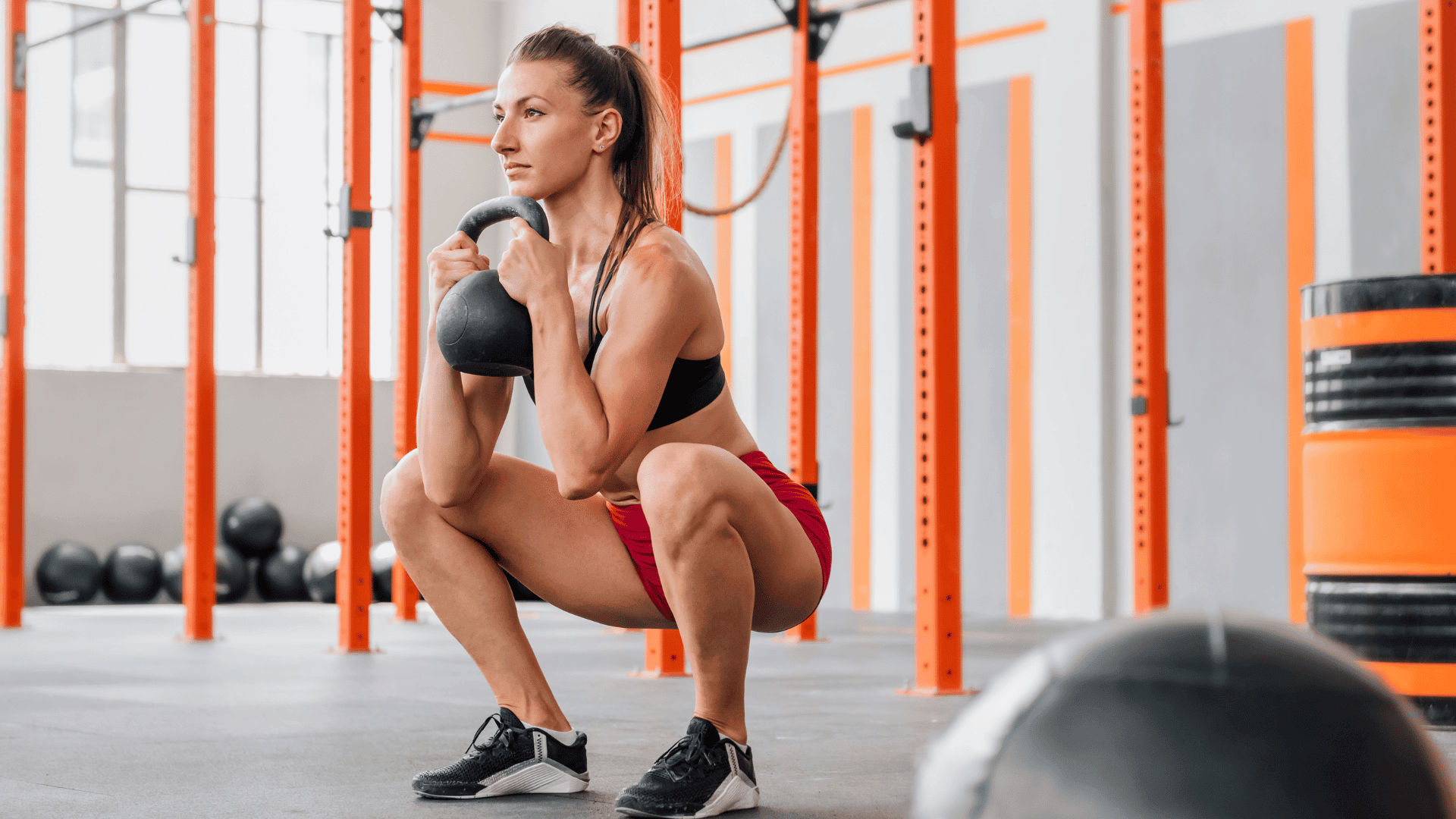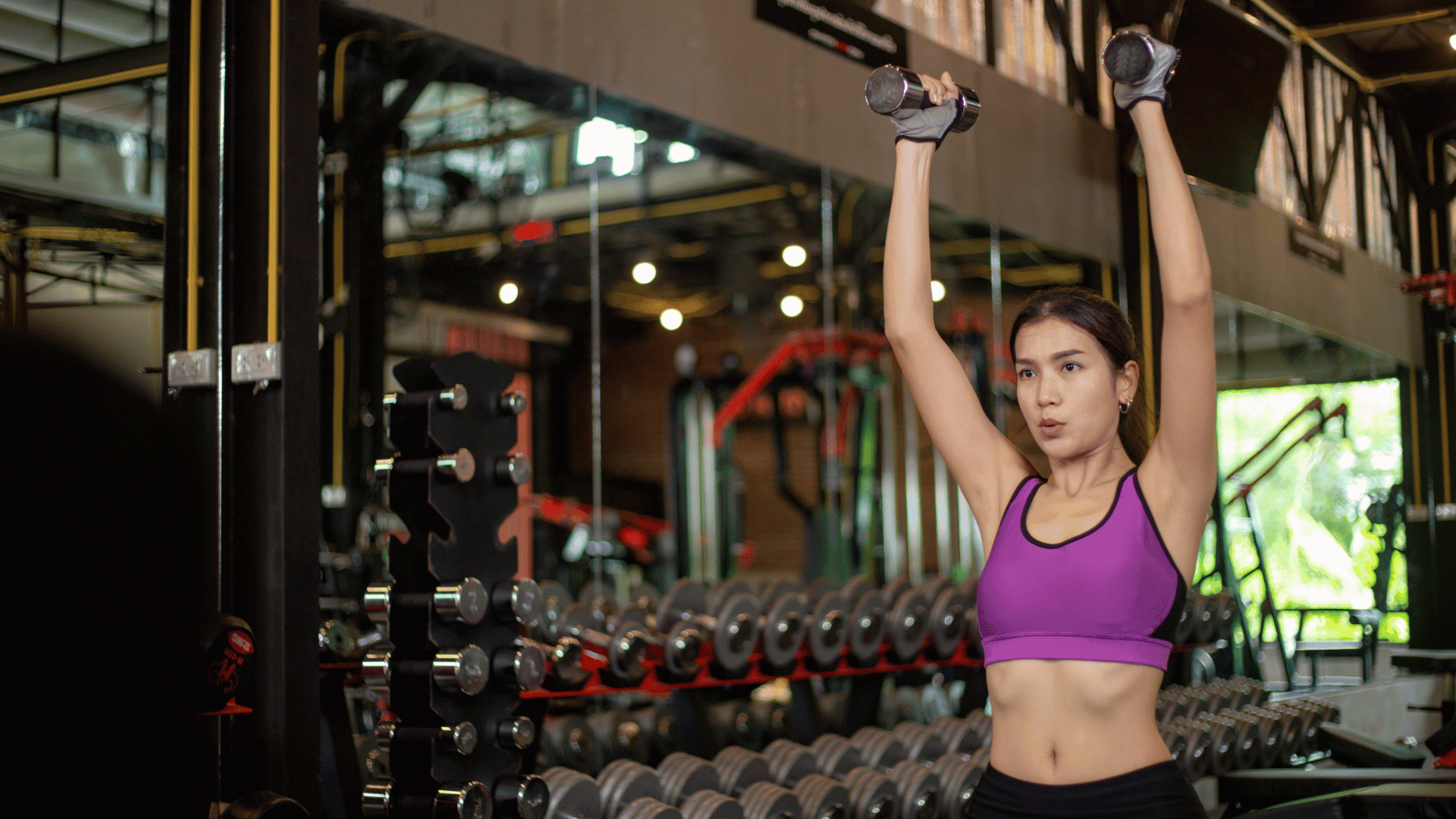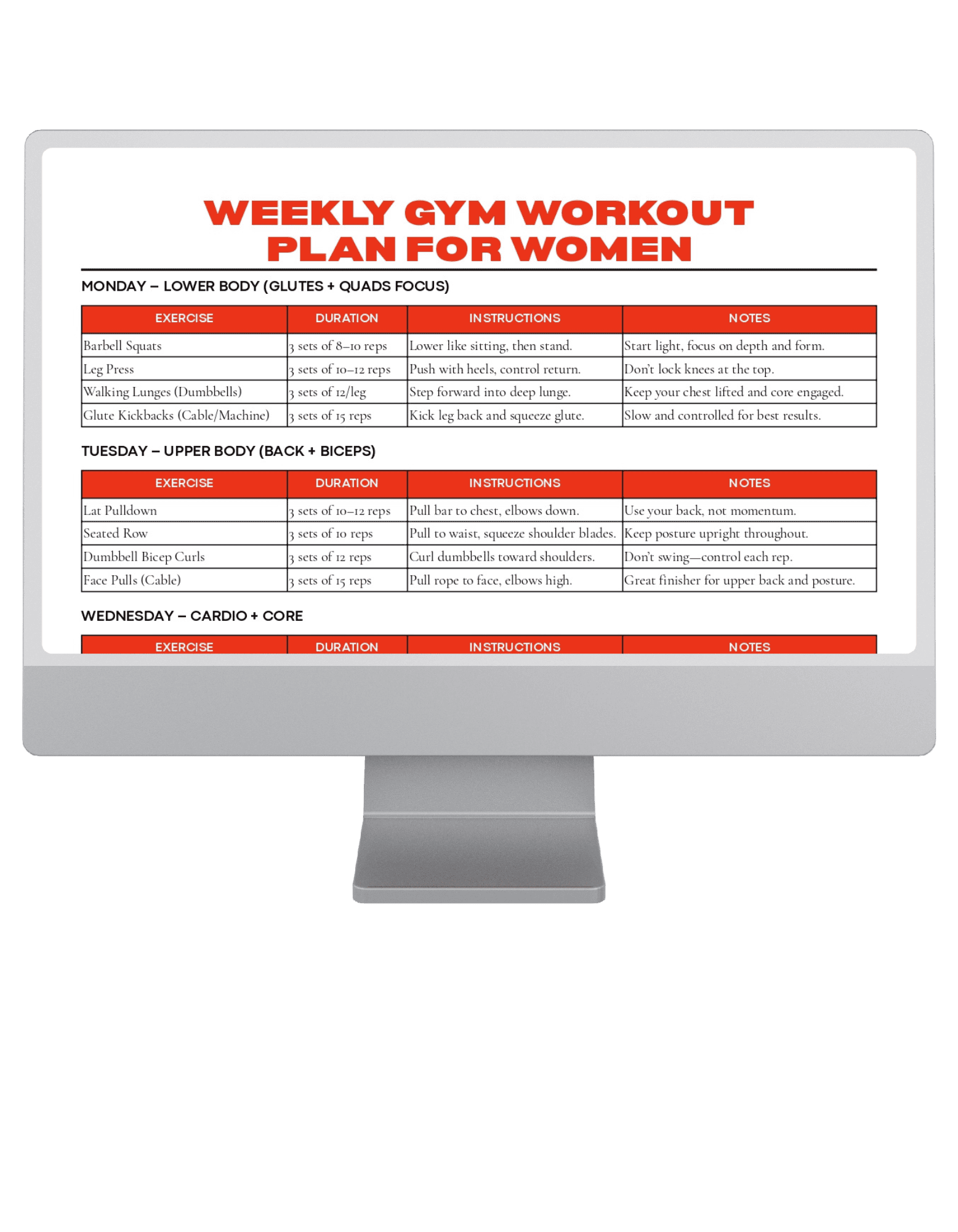Do you ever walk into the gym and just stand there wondering what to do?
Well, it’s a common thing.
You’ve carved out the time, made it there, but now you’re stuck figuring out where to begin and what even works. One day it’s all cardio. Next, maybe some machines. Then nothing for three days.
That kind of guessing gets old fast.
But having a set workout plan takes out the guesswork. It gives you structure, saves you time, and helps you actually see progress.
Because you’re not just moving around the gym hoping it works. You’re following a routine that’s built to do what most women want: build strength, burn fat, and stay consistent.
In this blog post, you’ll get a full weekly gym workout plan that’s easy to follow and fits into your busy life. It combines strength training with steady cardio, targets every major muscle group, and includes rest days so your body can recover right.
Everything is laid out for you, just show up and follow along.
But What Makes This Gym Workout Plan Work?

It’s easy to find a workout plan online. The hard part is finding one that actually fits into your life and helps you stick with it.
That’s what makes this one different. You’re only in the gym four days a week, and every workout is mapped out from start to finish. You’ll do a mix of strength and cardio, hit every major muscle group, and still have time for rest.
Each day focuses on something a little different. (upper body, lower body, or full-body strength)
At the end of each workout, you’ll do 20 to 30 minutes of steady cardio. Nothing crazy, just a good pace that helps you burn fat and build endurance without wearing yourself out.
The strength part uses a simple setup. You’ll start with 12 reps, then go to 10, then 8. As the reps go down, the weight goes up. That way, you’re getting stronger week after week without overdoing it.
This plan gives you structure, but still leaves room for real life. You don’t have to work out every single day or wonder what to do next. It’s already laid out. You just show up, follow the steps, and keep going.
Here’s What Your Week Looks Like
Now that you know how this gym plan works, here’s how the week is set up. The workouts are split into upper and lower body days, and each one ends with steady cardio to keep your energy up and fat burn steady. You’ll get stronger, feel more capable in your day-to-day, and stay consistent without overdoing it.
Now, let’s walk through your week, step by step:
Day 1 – Upper Body Strength + Cardio

You’ll work your arms, chest, shoulders, and back. These moves help you lift, carry, and move better in daily life.
Strength (3 sets of 12, 10, then 8 reps — go heavier each round):
- Incline Dumbbell Press: Lie back on a bench with the top slightly raised. Hold a dumbbell in each hand and press them up over your chest, then lower them slowly. This targets your chest and shoulders.
- Bent-Over Rows: Stand with your knees slightly bent. Hold dumbbells and lean forward a bit. Pull the weights toward your waist, squeezing your shoulder blades, then lower slowly. Great for upper and mid-back.
- Shoulder Press: Sit or stand tall with a dumbbell in each hand at shoulder height. Press them up until your arms are straight, then lower them with control. This strengthens your shoulders and arms.
- Leg Raises (Core): Lie on your back, legs straight. Slowly lift both legs until they’re pointed at the ceiling, then lower them down without touching the floor. Helps tone your lower abs.
Then, move on to cardio:
Do 20–30 minutes of steady movement. You can walk on the treadmill, cycle, or use the elliptical. Keep a pace that gets your heart rate up but still lets you talk.
Day 2 – Lower Body Strength + Cardio

Now it’s time to focus on your legs and glutes. These moves help with balance, strength, and posture.
Strength (3 sets of 12, 10, then 8 reps):
- Goblet Squats: Hold one dumbbell at chest level. Stand with your feet shoulder-width apart, lower into a squat, then push back up through your heels. This targets your thighs and glutes.
- Walking Lunges: Step forward with one leg, lower your back knee toward the ground, then push back up and step with the other leg. This builds strength in your legs and improves balance.
- Leg Press (Machine): Sit in the machine with feet on the platform. Push the weight up, then lower it down with control. Great for your quads and hamstrings.
- Stiff-Leg Deadlifts: Stand holding dumbbells in front of your thighs. Keep your legs mostly straight and lower the weights toward your feet, then rise back up. Works your hamstrings and glutes.
- Calf Raises: Stand tall and slowly lift your heels off the ground, then lower back down. This strengthens your calves and ankles.
- Crunches (Core): Lie on your back with knees bent. Lift your shoulders off the floor using your abs, then lower back down. Simple and effective for upper abs.
After that, add in 20–30 minutes of cardio:
Choose something light, like the elliptical or treadmill. Keep your pace steady and manageable.
Day 3 – Rest or Light Movement
Midweek is a good time to take a break. Go for a short walk, do some gentle yoga, or stretch at home. Giving your body time to rest helps your muscles grow and recover.
Day 4 – Upper Body (New Moves) + Cardio

Next up is another upper body workout, but with new moves to keep things fresh.
Strength (3 sets of 12, 10, 8 reps):
- Lat Pull-Down (Machine): Sit with your knees under the pad. Grab the bar and pull it down to your chest, then slowly let it go back up. This builds strength in your back and arms.
- Flat Bench Press: Lie flat on a bench with a dumbbell in each hand. Press the weights up above your chest, then lower with control. Targets chest and triceps.
- Lateral Raises: Stand with dumbbells at your sides. Raise both arms out to the sides to shoulder height, then lower. Great for shaping the shoulders.
- Hammer Curls: Hold dumbbells with your palms facing your body. Curl them toward your shoulders, then lower. This works the front of your arms.
- Triceps Extensions: Hold one dumbbell with both hands behind your head. Lift it overhead, then lower back behind your head. Helps tone the back of your arms.
Then, wrap up with 20–30 minutes of cardio:
Stick with walking, biking, or something low-impact. Keep it smooth and steady.
Day 5 – Lower Body (Different Focus) + Cardio

To finish off your strength days, this workout targets the lower body again, with new movements.
Strength (3 sets of 12, 10, 8 reps):
- Barbell or Bodyweight Squats: With or without weights, squat with good form — feet hip-width apart, chest up, and knees tracking your toes. Builds total leg strength.
- Deadlifts: Similar to stiff-leg deadlifts, but with more bend in the knees. Use dumbbells or a barbell. Strengthens the whole backside.
- Step-Ups: Step up onto a box or bench using one leg, then bring the other up. Step back down and switch legs. Great for glutes and balance.
- Hip Abduction/Adduction (Machine): Sit in the machine and press your legs outward (abduction) or inward (adduction). These moves target your inner and outer thighs.
End your session with another 20–30 minutes of steady cardio.
Days 6 & 7 – Full Rest or Gentle Movement
Finally, it’s time to rest. Relax, recover, and get ready for next week. A casual walk or light stretch is fine, but avoid anything intense. Your body needs this time to rebuild and stay strong.
A Few Tips to Make This Plan Work Better for You

Starting a new workout plan is one thing, making it fit your life is another. You don’t need to overhaul your entire schedule. You just need a few smart habits that help you stick with it.
First, try to keep each session under an hour. That includes your cardio. Most days, you’ll be done in 50 to 60 minutes. Set a timer if that helps you stay on track.
Next, move at your own pace. There’s no need to rush through your sets just to finish faster. Take your time with each rep so you’re using the right muscles and not just going through the motions.
Before each workout, warm up with a few minutes of light cardio—like walking on the treadmill or cycling—and add some dynamic stretches. This helps your body ease into the work and lowers your chance of injury.
On your rest days, keep things light and easy. A short walk, a stretch session, or some foam rolling goes a long way in helping you recover without losing momentum.
And don’t forget about your core. A little ab work each session can help with posture, balance, and even fat loss over time. It doesn’t take long, just a few focused moves can make a difference.
These small steps might seem simple, but they make your routine smoother, safer, and easier to stick with.
A Quick Note Before You Get Started
Starting something new can feel big. Even when the plan is laid out, it still takes effort to walk through those gym doors and begin.
But here’s the thing…
You’re already ahead by showing up with a plan. That alone puts you in a better spot than guessing your way through a workout.
You don’t need to be the strongest in the room or get every rep perfect. What matters is that you’re doing this for yourself. Every time you choose to lift, to move, or to stay consistent, you’re building something stronger, inside and out.
Progress won’t always be fast. Some days will feel harder than others. But those small steps you take, week after week, add up to real change.
So take a deep breath, grab your water, and get started. You’ve got everything you need to make this plan work and you’re more capable than you think.
Stay Consistent and See Results Faster

You’ve just gone through a full weekly gym workout plan for women to build strength and burn fat. Having a clear routine is the difference between walking into the gym feeling lost and walking in with confidence.
That’s why we created the Weekly Gym Workout Plan for Women. It’s designed to take the guesswork out of training so you can focus on showing up and making progress.
Frequently Asked Questions
1. How many weeks should I follow this plan?
This workout plan is designed to be followed for 8 weeks. That gives your body enough time to adapt, get stronger, and see results. You can repeat it again or move on to a more advanced program when you’re ready.
2. Can I do this plan if I’m new to lifting?
Yes. The plan is beginner-friendly. Just start with lighter weights, go slow, and focus on learning the moves. Over time, you can increase the weight or reps as you get stronger.
3. What is Zone 2 cardio, and how do I know I’m doing it right?
Zone 2 cardio means working at a steady pace where your heart rate stays around 60–70% of your max. You should be able to talk, but not sing. Think of a brisk walk, steady cycling, or light jogging—enough to break a sweat without going breathless.
4. What should I do if I miss a workout?
Just keep going with the next day’s session. Don’t try to double up or “make up” missed workouts. Life happens, and one missed day won’t ruin your progress.
5. Do I need to change anything with my food?
While this post doesn’t include a full meal plan, eating enough protein, drinking water, and staying consistent with meals will support your workouts. Focus on whole foods when possible and eat enough to fuel your training.










